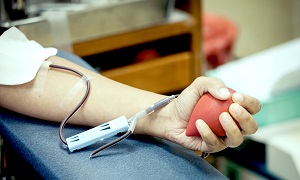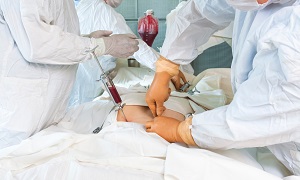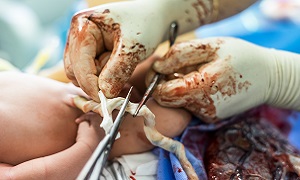ما هي عملية زراعة نخاع العظم؟
زراعة نخاع العظم، والتي تسمى أيضًا زراعة الخلايا الجذعية، هي إجراء طبي يُنصح به في حالة تلف نخاع العظم. والهدف الرئيسي من الإجراء الطبي هو استبدال جزء من نخاع العظم الذي تم تدميره بسبب بعض الأمراض أو العدوى أو بسبب العلاج الكيميائي. ومع ذلك، يجب أن تضع في اعتبارك أن هذا ليس إجراءً جراحيًا ولكنه إجراء طبي يتضمن زرع خلايا جذعية الدم المتدفقة إلى نخاع العظم.
يعزز استبدال خلايا جذع الدم نمو خلايا الدم والأنسجة الجديدة حول نخاع العظم مما يعزز بدوره التعافي السريع للمنطقة التالفة. وهذا هو السبب الرئيسي وراء تسمية هذا الإجراء أيضًا بزراعة الخلايا الجذعية.
متى ينصح بإجراء عملية زراعة نخاع العظم؟
ينتج نخاع العظم خلايا دم صحية تعمل على توزيع الدم في الجسم. غالبًا ما يُنصح بزراعة نخاع العظم عندما يتحول نخاع العظم أو يتوقف عن العمل.
أنواع زراعة نخاع العظم
هناك ثلاثة أنواع رئيسية من عملية زراعة نخاع العظم:
زراعة نخاع العظم الخيفي
زراعة نخاع العظم الذاتي
زراعة دم الحبل السري
يعتمد نوع عملية الزرع المطلوبة لك على الحالة الطبية التي يتم علاجها وتوافر المتبرع.
زراعة نخاع العظم الذاتي
تعتمد عملية زراعة نخاع العظم الذاتي على الحصول على الخلايا الجذعية من جسم المريض قبل إخضاعه لأي إجراءات طبية مثل العلاج الكيميائي أو الإشعاعي. يشير مصطلح “Auto” إلى “self” مما يعني أن الخلايا الجذعية المستخرجة من المريض يتم تبريدها وعندما يحين الوقت يتم حقنها مرة أخرى في الجسم. يُعرف هذا النوع من عمليات الزرع أيضًا باسم عملية الزرع الإنقاذية.
زراعة نخاع العظم الخيفي
تعتمد عملية زراعة نخاع العظم الخيفي على الخلايا الجذعية المأخوذة من شخص آخر، والمعروف عادة باسم “المتبرع”. يشير مصطلح “Allo” إلى “الآخر”، مما يعني أن الخلايا الجذعية يتم التبرع بها من قبل “المتبرع” بعد إجراء بعض الاختبارات السريرية للتأكد من أن المتبرع مناسب لـ “المستقبل” أو المريض.
يمكن أن يكون المتبرعون في هذه الحالة إما قريبين من المريض عن طريق الدم أو يمكن أن يكونوا مطابقين غير مرتبطين يتم العثور عليهم من خلال أدلة نخاع العظم الوطنية.
زراعة دم الحبل السري
إن عملية زراعة دم الحبل السري هي نوع من عمليات زراعة الخلايا الجذعية المتماثلة حيث يتم استخراج الخلايا الجذعية من الحبل السري للطفل حديث الولادة مباشرة بعد ولادته. ثم يتم تجميد الخلايا الجذعية وتخزينها حتى تصبح هناك حاجة لعملية زرع.
ومع ذلك، فإن الخلايا الجذعية المستخرجة من الحبل السري عادة ما تكون صغيرة العدد، وهذا هو السبب في أن التعافي قد يستغرق وقتًا أطول من الإجراءات الأخرى. الجانب الإيجابي لعملية زراعة دم الحبل السري هو أنه نظرًا لطبيعته النقية، فإن جذوع دم الحبل السري لا تخضع عادةً للعديد من اختبارات المطابقة السريرية.
اختبارات التشخيص الشائعة
عادةً ما يتم إجراء فحص دم أو خزعة نخاع العظم لتحديد ما إذا كانت عملية زرع نخاع العظم ضرورية أم لا. قد تشمل الاختبارات الأخرى تحديد نوع الأنسجة واختبارات الرئة والأشعة السينية ومسح التصوير المقطعي بالإصدار البوزيتروني.
عملية زراعة نخاع العظم
تعتبر عملية زراعة العظام عملية طويلة للغاية تستغرق ما يقرب من شهر. وفيما يلي شرح لكيفية سير العملية.
استخراج الخلايا الجذعية:
تبدأ عملية زراعة نخاع العظم باستخراج الخلايا الجذعية. هناك ثلاثة أجزاء رئيسية في الجسم توفر أفضل الخلايا الجذعية، وهي:
الدم، وهو المنطقة الأكثر شيوعًا لاستخراج الخلايا الجذعية
نخاع العظم، المستخرج من منطقة عظم الذيل
الحبل السري
الاستخلاص من الدم
- يجب عليك تناول دواء سريري لتعزيز عدد الخلايا الجذعية. عندما يحين الوقت، يتم أخذ الدم من أحد الذراعين ليتدفق إلى جهاز يقوم بتصفية الخلايا الجذعية. ثم يتم ضخ الدم المتبقي خارج الجهاز وإلى الداخل من خلال الذراع الأخرى.
تستغرق العملية بأكملها حوالي 2-3 ساعات وهي غير مؤلمة تمامًا. على الرغم من عدم الحاجة إلى الإقامة في المستشفى، فقد تحتاج إلى الخضوع لهذه العملية لفترة أطول
الإستخلاص من نخاع العظم
استخراج من الحبل السري
التكييف
بمجرد أن تصبح الخلايا الجذعية جاهزة وتقترب من موعد عملية الزرع، يجب أن تخضع لإجراء يسمى التكييف والذي يتضمن في الغالب العلاج الكيميائي أو الإشعاعي. يتم إجراء هذا الإجراء لقتل أي أثر للخلايا التالفة أو المصابة في دمك. يساعد التكييف أيضًا بشكل استباقي في خفض مستويات المناعة في جسمك ويوفر مساحة أكبر لدخول الخلايا الجديدة.
يمكن أن تكون العملية إجراءً لمرة واحدة أو مقسمة على بضعة أيام بناءً على رد فعل جسمك ونوع التكييف أو إجراء زراعة نخاع العظم الذي ستخضع له.
بناءً على شدة حالتك الطبية إلى جانب معايير أخرى مثل العمر والجهاز المناعي للجسم والمزيد – قد يوصي الأطباء بجرعة مخفضة من العلاج الكيميائي أو الإشعاعي أثناء عملية التكييف، والتي تُعرف باسم التكييف منخفض الكثافة.
اليوم صفر لعملية زرع نخاع العظم
بعد بضعة أيام من عملية التكييف، تتم عملية الزرع. ويُعرف يوم الزرع أيضًا باسم اليوم صفر، ويجري في معهد طبي تحت إشراف فريق أمراض الدم.
يتم نقل الخلايا الجذعية الجديدة إليك من خلال أنبوب رفيع يسمى الخط المركزي والذي سيتم توصيله بوريد في صدرك. قد تستغرق العملية ما يصل إلى بضع ساعات ولكن العملية برمتها غير مؤلمة على الإطلاق وستكون مستيقظًا واعيًا طوال العملية.
ومع ذلك، يبدأ التأثير في الظهور بعد بضعة أيام من عملية الزرع.
الآثار الجانبية المحتملة لعملية زرع الأعضاء
غالبًا ما تحتوي الخلايا الجذعية المجمدة على مادة حافظة قد تكون مسؤولة عن بعض الآثار الجانبية. يصف الأطباء الأدوية ويوصون بالسوائل الإضافية لطرد المواد الحافظة من جسمك. ومع ذلك، فإن الآثار الجانبية الأكثر شيوعًا للمواد الحافظة يمكن أن تكون في شكل
الحمى والغثيان
القشعريرة
الشرى
ألم الصدر
الصداع
صعوبة التنفس
الآثار الجانبية العامة لعملية زراعة نخاع العظم
قد يعاني المرضى من آثار جانبية خفيفة إلى معتدلة تظهر بعد أيام قليلة من يوم الزرع أو التكييف. يمكن أن تكون هذه الآثار في شكل:
الإسهال
تقرحات الفم والجروح
مشاكل النزيف المفاجئ
التعب والغثيان
في حالة حصولك على خلايا من متبرع مختلف، فقد تكون عرضة لمرض GVHD أو مرض الطعم ضد المضيف حيث تعالج الخلايا الجذعية الجديدة جسمك مثل الأجسام المضادة الغريبة وتهاجمه.
رعاية ما بعد عملية الزرع
ما يحتاجه المرضى أكثر من غيره بعد عملية زراعة نخاع العظم هو الحب والرعاية والدعم من أفراد الأسرة المقربين والأصدقاء. إليك بعض النصائح للعناية المنزلية التي يجب وضعها في الاعتبار-
اطلب من طبيبك مخططًا تفصيليًا للحمية الغذائية مع قيود مثل عدم التدخين أو شرب الكحوليات بشكل واضح.
تجنب زيادة الوزن بعد عملية زراعة النخاع
مارس الرياضة بانتظام للحفاظ على وزنك ولكن تأكد من القيام بذلك باعتدال.
تأكد من أخذ متابعة الطبيب على محمل الجد
الأسئلة الشائعة حول عملية زراعة نخاع العظم
تتطلب عملية زراعة نخاع العظم الإقامة في المستشفى لمدة تتراوح من 3 إلى 4 أسابيع وإقامة في الهند لمدة شهرين تقريبًا للمتابعات الروتينية.
من المعروف أن 2-4% فقط من المتبرعين بنخاع العظم يواجهون مضاعفات بعد التبرع. ومع ذلك، تم تسجيل حالات نادرة جدًا من المضاعفات طويلة الأمد.
تتم عملية زراعة نخاع العظم عادة تحت تأثير التخدير الموضعي أو الكامل، وبالتالي فإن الإجراء لن يسبب لك أي ألم على الإطلاق. ومع ذلك، فإن الآثار الجانبية بعد عملية الزرع قد تؤثر على المريض، وبالتالي يجب اتخاذ التدابير الاحترازية.
يتم استخراج 4-6% فقط من نخاع العظم من المتبرع لإجراء العملية، ويقوم الجسم بتجديد الكمية المفقودة خلال 4-6 أسابيع. غالبًا ما لا يتأثر الجهاز المناعي للمتبرع، مما يعني أن معدل تعافيك كمتبرع سيعتمد على جهاز المناعة لديك.
الهدف الأساسي من إجراء عملية زرع نخاع العظم هو القضاء على الخلايا السرطانية (في حالات السرطان) أو إطالة العمر. ومع ذلك، في بعض الحالات، قد يعود السرطان وقد يوصى بإجراء عملية زرع ثانية في مثل هذه الحالات.
في حالات نادرة، قد يرفض الجهاز المناعي للمريض الخلايا الجذعية الجديدة مما يؤدي إلى فشل عملية الزرع. في مثل هذه الحالات، هناك حاجة إلى المزيد من الخلايا الجذعية المتبرع بها للحصول على فرصة ثانية للزرع.
إن عملية مطابقة المتبرعين مفصلة للغاية مع إجراء اختبارات إضافية لضمان اختيار أفضل تطابق من المجموعة لإجراء العملية. وبالتالي، لا يمكن التنبؤ بفرص العثور على التطابق الصحيح.




